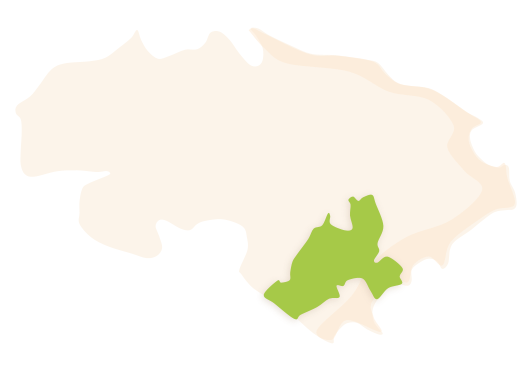Benissa is a municipality located in the southern part of the region, being almost the southernmost of all. It has the largest area in the whole of La Marina Alta, with an extension of 69.7 km2, and lies at an altitude of 254 metres above sea level. Benissa currently has 11,462 inhabitants, known as Benissers and Benisseres.
 Benissa's municipal district. Surface area: 69.7 km². Population: 11,462 (INE data 2021).
Benissa's municipal district. Surface area: 69.7 km². Population: 11,462 (INE data 2021).HISTORY
The municipality of Benissa has a vast extension with a heterogeneous orography. It features 4 km of coastline, located between the Crag of Ifac and El Portet de Moraira, made up of small coves and cliffs. In the centre, the rural areas with non-irrigated land stand out and, inland, there are some high mountains, like Bèrnia or the Ferrer mountain range (Serra del Ferrer).
The discovery of certain small cave paintings indicates that the earliest settlements date back to the Neolithic, at least, while the Roman period is thoroughly documented by the remains of coins and amphoras that have been discovered at the bottom of the sea, along the coastline.
However, to discover the origin of the name Benissa (bani Isa) it is necessary to study the Muslim period, because the term is of Arabic origin, just like many other parts of Benissa, such as Benimallunt, Ràpita or Alfama. Benissa —along with Teulada, Dénia, Calp, Pego, Xàbia, Murla and Ondara– was one of the population centres that remained eminently Christian. When Jaume I conquered these territories back into Christianity, new villages for the new Christian population were founded. Benissa is considered, along with Murla and Ondara, a mixed Christian village; it has suburbs or Moorish quarters to separate the Christian and Muslim populations. The Christian hearths constituted the majority of Benissa, while the Muslim population that remained was located in scattered rural communities: Benimallunt (11 houses), Albinyent (11) and Benimarraig (4).
It should be noted that during the 15th and 16th centuries, Benissa was attacked on numerous occasions by Barbary corsairs. After the expulsion of the Moorish population in 1609, its lands were repopulated by people that came from the Pyrenees, Catalonia and Aragon and, to a lesser degree, from the Balearic Islands and in particular from Llucmajor. The walls that surrounded the village are from this period. Some remains of these walls are still preserved.
FESTIVITIES
- Festivities in honour of the patron saint, La Puríssima Xiqueta, are held on the fourth Sunday of April.
- La Fira i Porrat de Sant Antoni (traditional fair of Saint Anthony) takes place from the second weekend to the fourth weekend of January.
- The festivities of Els Moros i Cristians (“Moors and Christians”) are celebrated from the 26th to 29th of June.
- The festivities of the rural areas: in July the festivities of the neighbourhood of Saint Antoni and the areas of Pedramala, in honour of Saint Vicent Ferrer, take place; Benimarco, in honour of Saint Jaume; the area of Santa Anna on the 26th of July, dedicated to its patron saint, and the area of Lleus on the 29th of July, in honour of the saints of La Pedra Abdó and Senent. The month of August, on the other hand, is the moment for the festivities in Pinos, in honour of Saint Bàrbara; in Berdica, dedicated to Saint Joaquim; and in Benimarraig, in honour of Saint Tereseta del Xiquet Jesús. During this same month there are the festivities of Fustera beach, Costa-Camarroja-Collao, Benillamunt, and also of the beach known as Platja de l’Advocat-Baladrar.
GASTRONOMY
- Putxero de polp: octopus stew. A typical fishermen’s dish, it is a version of the traditional stew but including octopus.
- Onion hulls with anchovies: a humble dish, which is very characteristic of the area, that contains grilled onions. The layers of the grilled onion are served with an anchovy inside and some olive oil.
- Mullador de bull: a snack dish that consists of tuna gut which is salted and cooked.
- If you like bakery specialties, it is worth tasting all types of flatbreads (“coques”) with cold meats, or the traditional “caspells”, which are a kind of salted and dry biscuits with oil and salt.